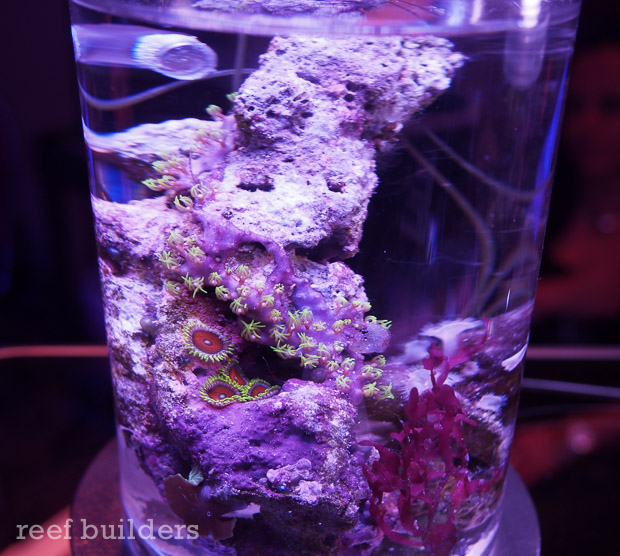Something that I’m continually fascinated with and ponder about; the idea of creating aquarium setups that require minimal human intervention. Growing up in the 90’s, the biosphere experiment held my imagination quite a bit. And then there were those ecospheres with the shrimp in the back of Smithsonian magazines. On a similar note, now people are keeping pico reefs in large glass jars. The PJ Reefs is an example we recently reviewed.

Recently, the internet went viral over David Latimer’s spiderwort growing in a bottle that has remained sealed for half a century! I think the idea of creating a small ‘ecosystems’ in a glass box is the fundamental reason why I remain interested in aquariums.
Ultimately, the biosphere did fail. It actually became a great model for studying climate change due to the excess CO2 emitting from the concrete. The “ecospheres” last maybe 5-7 years, and are ultimately inhumane to the shrimp involved. And likewise, the idea of a self sustaining aquarium is flawed. Without immigration and emmigration, populations and diversity decline due to predation, competition, and the occasional catastrophe.

Getting back to aquariums and now that we have prefaced that self sustaining aquariums are a myth…How close to a zero import/export system can we get and still maintain an appreciable amount of diversity and aesthetics? Unfortunately, evaporation and salt creep are two exports that hard to avoid, unless we fully seal the tank. And it’s easy to surmise that a larger system would sustain longer than a smaller tank. So let’s start with some ground rules:
1. The tank cannot exceed 40 gallons
2. The only input can be freshwater and salt to maintain salinity.
Let’s talk about the obstacles:
-Without any calcium and alkalinity management, stony corals would not do well. Adding aragonite sand would offer some help in slow dissolution, but not an appreciable amount. You’d be better off sticking with soft corals to keep calcium demands really low.
-The tank size also presents a problem as a food generator. Can the microfauna in a 40 gallon aquarium reproduce enough to sustain a small fish? Perhaps even one fish is too much predation from the start. And how does competition play out in such a small box. I suspect diversity drops off quickly. Partitioning part of the tank into a refugium would help.
-Trace elements would get consumed and end up in forms that are no longer bioavailable. Other elements might become more bioavailable and build up. Things would definitely get skewed over time.
As you can see, the idea complicates quickly. And I don’t really endorse people trying it, because I do not wish for a bunch of fish and coral to suffer for the purpose of an experiment. However, it is a fun mental exercise. For the real world, we need to make more allowances. We need to intervene more. I would argue allowing the following:
3. Allow the occasional water change to reset the water chemistry
4. Allow some type of calcium and alkalinity management
5. Allow the occasional input of food and the export of coral growth and algae.
Now we’re not far off from how many people probably manage some reef aquariums. In fact, I have a couple of systems pretty close to this idea. I refer to it as ‘careful neglect’. I used to have a 34 gallon skimmerless cube overgrown with soft corals and macroalgae. A/B additives and food were added weekly. A small Jan’s pipefish lived in this tank for quite a long time.
Right now, I also have a 30 gallon tank running with just airstones in the back of the basement. Xenia and Caulerpa help with nutrient management alongside the usual bacterial driven pathways. The only inputs are RO water and a little bit of food on the weekends. Macroalgae/Xenia is harvested occasionally, so that would count as an export. It’s essentially a Lee Chin Eng type setup. But there are no water changes or additives involved.
Last year I moved a Mauritius tiger-tail Coral Beauty to this tank that had been struggling in a heavily skimmed reef. The angel had developed hole-in-the head. The lateral line looked fine, it was just the head. Now it is fully healed! I suspect that the carbon and skimming had been the culprit in the original system. Perhaps a pump was leaking some electricity there too, while this tank runs on airstones. Who knows… I can’t believe that a tank with zero water changes will be good for the Coral Beauty long term, but for now it is doing much better. I’d like to move him back to my larger reef and see what happens to this tank without any large predators around.
Just like the biosphere, a neglected tank ultimately needs more intervention. Once diversity declines, a healthy reboot is needed. Maybe some water changes and fresh live rock. While self sustaining is a pipe dream, it’s a goal that is worth reaching for. You’ll never get there, but it’s an interesting journey and very enlightening. I would view it as a jumping off point into much deeper topics. In fact, a great area of study for any aquarist is island ecology and evolution. Islands represent somewhat isolated ecosystems, and it is fascinating to read how settlement occurs and how things change over time. How does a newly formed atoll or volcanic piece of rock eventually get colonized, and how do things evolve when isolated. It certainly mesmerized Darwin down in the Galapagos. Think of your tank as an island, except there’s no coconut washing ashore. It’s up to you to colonize, and recolonize as things change.




